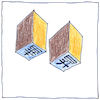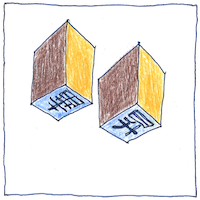Bi Sheng
manufacturing

|
Movable-type printing
During the Northern Song dynasty the commoner Bi Sheng cut characters into porcelain clay and fired them. He arranged these in an iron frame and pressed them into a thick paste of pine resin, wax, and paper ashes, creating the first movable-type printing method.
Imprints
1313, Nong Shu, or “Book of Agriculture” printed with wooden movable type, by Wang Zhen. 1377, Jikji, an anthology of zen teachings printed with metal movable type, in Korea. 1455, Biblia Sacra, the Gutenberg Bible printed with metal movable type by Johannes Gutenberg. 1574, Taiping Yulan, an encyclopedia of a thousand volumes, reprinted with bronze movable type. 1598, Confucian Analects printed in Japan using metal moveable type by order of Emperor Go-Yōzei.
First edition
I have in my possession certain first editions neither too old nor too rare. Of these there are few that I value more than I could sell them for. I know whose love once held them dear and why they are mine. What remains of a life as memories fade and loved ones die? Something about them— a familiarity, a smell, a reassurance.



Gutenberg introduced the hand mould, the mechanical printing press, and oil-based inks that allowed duplex printing. He made his type with an alloy of lead, tin, and antimony. The Gutenberg Bible was rubricated (it included words printed in red) and illuminated (intial letters were elaborated and painted by hand). The technologies that led to his work were goldsmithing, cutting dies for stamping coins, and Roman screw presses for producing wine and olive oil.
See also in The book of science:
Readings in wikipedia: